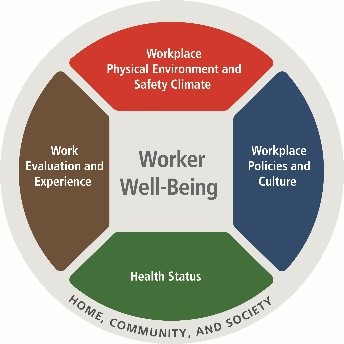Mission Possible: Measuring Worker Well-Being
Posted on byHow can we measure worker well-being? Worker well-being is an important occupational health concern, but our current understanding is limited by the lack of a standard way to define and measure this concept. The development of a new tool, the NIOSH Worker Well-Being Questionnaire – or NIOSH WellBQ, may help employers and workers overcome this limitation and answer this important question.
In 2014, the NIOSH Total Worker Health® Program, in partnership with RAND Corporation, led an effort to first define the elusive concept of worker well-being. Recognizing the need for a comprehensive approach, they developed a new conceptual framework for worker well-being.
Framework for Worker Well-Being
Published in 2018, the article Expanding the Paradigm of Occupational Safety and Health: A New Framework for Worker Well-Being defines worker well-being as “an integrative concept that characterizes quality of life with respect to an individual’s health and work-related environmental, organizational, and psychosocial factors. Well-being is the experience of positive perceptions and the presence of constructive conditions at work and beyond that enables workers to thrive and achieve their full potential.” The framework encompasses all factors that influence the quality of workers’ lives, not just conditions at work, and identifies five domains:
 Work evaluation and experience: A person’s experiences and evaluations of the quality of their work life.
Work evaluation and experience: A person’s experiences and evaluations of the quality of their work life.- Workplace policies and culture: Organizational policies, programs, and practices that can influence worker well-being.
- Workplace physical environment and safety climate: Factors that relate to physical and safety features of the work environment.
- Health status: Aspects of a person’s life that relate to their physical and mental health and welfare.
- Home, community, and society: External aspects of a person’s life that are situated outside of work but may still influence worker well-being.
A Holistic Approach to Worker Well-Being
The worker well-being framework is unique in addressing “worker” well-being as a holistic construct rather than simply “workplace” or “work-related” well-being. This aligns with the NIOSH Total Worker Health (TWH) approach, which offers a more comprehensive model for improving workforce safety, health, and well-being. This approach advocates for comprehensive interventions that address risks and protective factors across all five well-being domains.
A New Way to Measure
Based on this framework, NIOSH and researchers at the RAND Corporation developed the NIOSH WellBQ. The questionnaire provides an integrated assessment of worker well-being across these five domains.
The NIOSH WellBQ is the first tool to use the new conceptual framework and measure worker well-being. The items in the questionnaire were strategically selected based on their relevance to these domains. These include both new items and items adopted from existing tools to create one questionnaire that is uniquely equipped to capture and measure the concept of worker well-being.
Value of the NIOSH WellBQ
Anyone interested in understanding or improving worker well-being may find the NIOSH WellBQ helpful. The NIOSH WellBQ can be used by researchers, employers, practitioners, policymakers, and workers across various organization and workplace settings. The NIOSH WellBQ can help:
- Set benchmarks internal to an organization or workforce
- Examine changes over time or assess the impact of interventions
- Compare results between groups within the same facility or workforce or across organizations or working populations
How would you use the NIOSH WellBQ? Share your thoughts in the comments below!
Emily Norton, BPH, is a Public Health Advisor in the NIOSH Office of Communication and Research to Practice.
Sydney Webb, PhD, is a Health Communication Specialist in the NIOSH Office of Communication and Research to Practice.
L. Casey Chosewood, MD, MPH, is Director of the NIOSH Office for Total Worker Health.
Chia-Chia Chang, MPH, MBA, is a Public Health Analyst in the Office for Total Worker Health.
Steven Sauter, PhD, is a consultant to the NIOSH Total Worker Health Program.
Posted on by

